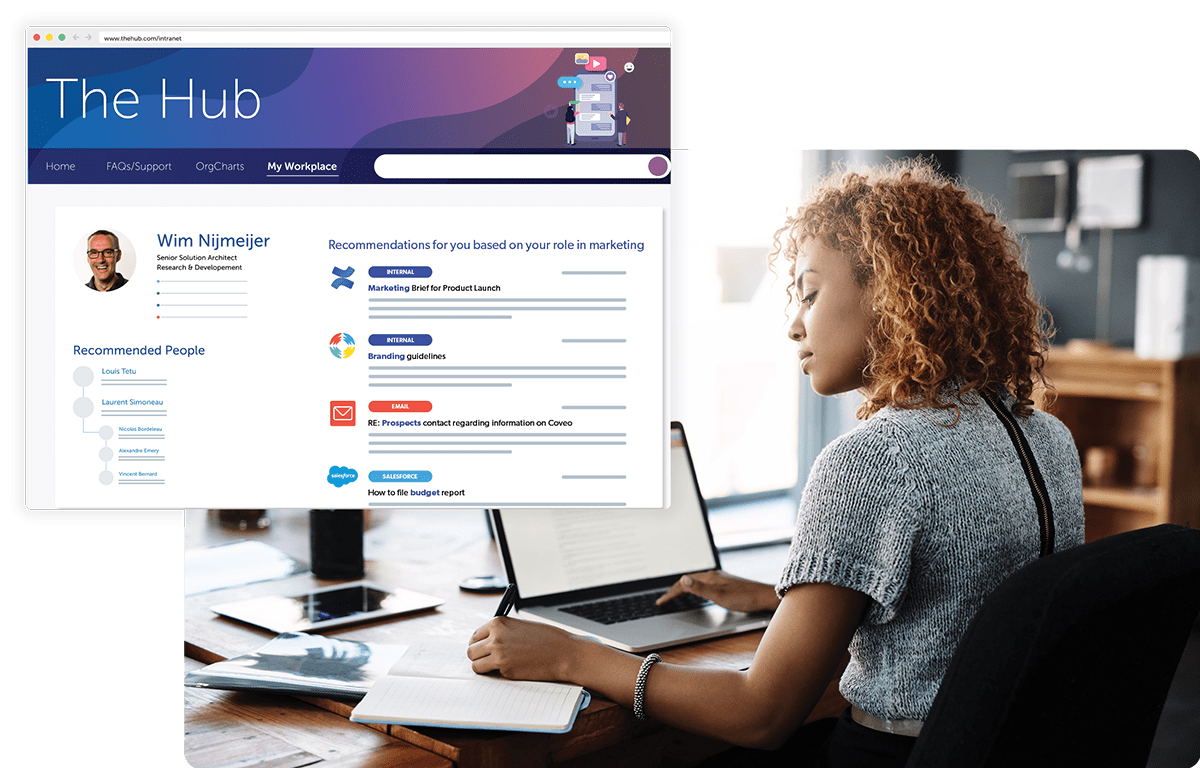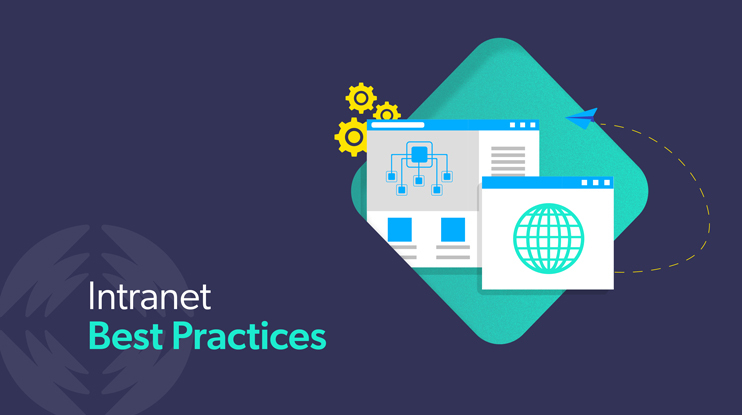Today’s distributed workplace is reliant on technology to keep employees connected and engaged. So, it comes as no surprise that company intranets are in the spotlight for 2025.
Traditional intranets don’t meet current expectations for employee engagement, digital experience, and innovation. And if companies are to avoid the failure met by an estimated 90% of intranet projects, they must rethink what actually matters in creating a trusted, centralized source of workplace knowledge. While this can often result in needing to adopt new technologies (such as generative AI), this is just one aspect of a bigger solution.
According to Jesse Murray, Senior VP and Head of Employee Experience at Rightpoint (a Coveo partner), “Adoption isn’t a technology issue, it’s an employee experience issue. Organizations that excel at employee experience have built relationships across the organization to generate the best outcomes.”
Off-the-shelf intranet systems can offer a lot of bells and whistles, but that might be missing the main aspect that employees need most: the ability to find what’s needed, when it’s needed. On top of this, embracing advanced knowledge management practices and exploring generative AI have become top of mind in maximizing the effectiveness of intranets in 2025.
The following intranet best practices will help you to focus on what really matters to employees.
Why are Intranets Important for Modern Businesses?
According to a 2024 Forrester report, 71% of AI decision-makers told Forrester their companies are experimenting with or expanding their use of generative AI for internal applications. Intranets are a linchpin to building an effective and connected workforce, especially in a hybrid or remote environment.
Furthermore, a 2024 Deloitte study found that 75% of organizations have increased their technology investments around data life cycle management due to generative AI.
What Are the Most Important Functions of an Intranet?
Ultimately, an intranet should give employees access to the most important information for them, on a single page, and by doing so, increase employee engagement.

Modern intranets include two essential elements:
- A comprehensive search engine that indexes knowledge and information from relevant company data sources, while respecting source security and permissions.
- AI models that individually personalize the content that each employee sees, possibly leveraging generative AI to synthesize delivery and consumption of answers.
These two elements work together to help create an engaged workforce bte an engaged workforce by making the content on your intranet relevant and increasing adoption.
6 Best Practices To Build a Successful Intranet
Employees today are overwhelmed by information across multiple channels and often have to filter out what’s not applicable to them.
Successful employee intranet design does this filtering for them, serving only what’s relevant and encouraging each employee to carry out their best work – without the extra noise that leads only to frustration. Moizeau advises considering the “three E’s”: engagement, enablement, and empowerment. Each stage presents an opportunity to assess not just whether employees are using your intranet, but how — and establishing metrics to measure success by.
“The point is that as your progress from engagement to enablement to empowerment, we see growing value for the business and return on investment for the organization,” Moizeau says.
Here’s what you can do to create a more relevant, trusted company intranet to increase employee engagement.
1. Define an intranet strategy with measurable goals.
Your intranet delivers specific workplace benefits, so it should have its own strategy that’s aligned with your overall business goals. Without a strategy, your intranet will lack direction and ultimately run out of steam.
Ask yourself the following questions to help guide your intranet strategy:
- What value do your employees expect to get from your intranet? Knowledge discovery is usually top of the list. Think about the role a modern intranet has in onboarding, training and upskilling employees. Finding relevant information in the moment of need is what really matters.
- Are you maintaining clean and well-structured data to maximize efficiency? Data is the cornerstone of successful knowledge discovery and can make or break a digital experience. If your processes aren’t supporting your design, or vice versa, you’re setting yourself up for failure.
- Are there use cases where AI tools like generative answering can enhance the employee experience? According to our 2024 EX Industry Report, 52% of field support and 50% of sales expressed the desire to use generative AI to better serve customers and prospects.
- How will you keep your intranet adaptable to business change? Consider how to make your intranet flexible and scalable. This can mean adopting a composable hybrid AI search platform that grows with your business, instead of relying on content migrations that require regular maintenance.
- How will you deliver your intranet project? Your intranet roadmap should outline a phased approach to accomplishing your goals of increasing employee engagement through providing relevant information. Identify where you can make improvements right away, such as upgrading your current search tool with a modern platform, and then how you can scale these improvements across the enterprise by merging departmental knowledge bases, for example.
Measuring success is important to understand if a project is going off track and how to course correct. Consider these metrics to evaluate where pain points exist and how to best address them:
- Employee adoption. How many of your employees are using the platform, and how many visits per day do they make?
- Time to access knowledge. Tracking successful search sessions will show you how effectively employees access knowledge and allow you to estimate productivity improvements.
- Average click rank. This shows you how well your intranet search engine matches user intent in delivering relevant results.
- Employee satisfaction. Create feedback surveys that you can use to find out how satisfied employees are with your new and improved intranet.
- Generative AI adoption and effectiveness. Monitor how employees are using AI tools and the impact on their productivity and satisfaction.
To track these metrics, you need robust reporting for both search results and how employees interact with the content they receive. tranet search engine and interactions with the content that’s proactively displayed to employees.
2. Consult your employees to understand what matters to them the most.
Your employees are the ones using your intranet, and they ultimately determine its success or failure. So it makes sense to involve them early in the planning process to make sure you’re delivering the right improvements to increase engagement.
Designing a modern intranet requires an understanding of how your employees work, what their information needs are, and how they interact with the applications used within your enterprise.
There are several ways to engage your employees in intranet planning and get valuable feedback. You can conduct interviews with team leads, run company-wide surveys, host workshops, and invite people to test your improved intranet platform before it goes live. You can also review analytics to understand how your employees are using your existing intranet and pinpoint exactly where improvements can be made.
Think about asking employees the following questions to get the best feedback:
- What is most important to you about a corporate intranet?
- What do you like and dislike about our current intranet?
- What information do you want to see?
- What information do you not want to see?
- What user experience improvements are likely to encourage you to use the intranet more?
- Are you comfortable using AI tools in your daily tasks? Do you need additional training or support to make the most of these tools?
Once you have this feedback, you can start designing your modern intranet.
3. Unify content from across the enterprise.
If employees can’t find what they’re looking for on your intranet, they won’t use it. They’ll decide they have no option but to continue searching within other platforms to find what they need.
Breaking down knowledge silos requires many things, but perhaps the most important is knowledge owner/creator buy-in. And one way to encourage this buy-in is through technology. When one team sees another team having an easier, more successful time as a result of, say, a more robust search engine that unifies content access, the fear of missing out can kick in.
Knowledge and answers can lie piecemeal across your enterprise, and sometimes employees don’t know what they don’t know because content sits behind denied access. The more you can unify content, both structured and unstructured, the more you can make it actionable and useful for your business at large. It can also save on maintenance costs. A modern unified index automatically includes new content as it is created, wherever it lives. As your company grows and new content is developed, that content is immediately indexed and made searchable within your intranet.
Without a unified index, you are constantly maintaining and updating your intranet content, often migrating new knowledge from other platforms. This lack of agility comes at a cost to both your development and knowledge management teams, and it decreases employee engagement.
Relevant viewing: Smart Search Strategies with the Coveo Platform™
Moreover, maintaining clean and well-organized data is crucial for AI effectiveness. As Dan Shapiro, Associate Director of Enterprise Knowledge and Content Management at Organon has observed, “You still have to have good foundation content. If not, if you have bad content, you’re just going to get bad AI out at the end of it.”
4. Personalize the experience for each employee.
Personalization is what sets a winning modern intranet apart from a misfiring one. It’s how you provide a truly relevant experience to each employee, making them feel more understood, engaged, and empowered with every interaction.
Of course, personalization is far from straightforward in today’s remote/hybrid workplace. How do you personalize the employee experience in an enterprise comprising many roles, departments, locations and even languages?
Most enterprises don’t — instead ending up with multiple dedicated departmental or location-based knowledge hubs. But this approach only reinforces the costly impact of knowledge silos, while doing the bare minimum to filter out that noise for employees.
That’s why the world’s most innovative organizations leverage machine learning to deliver real, one-to-one personalization within the digital workplace. This works in a company intranet by automatically tailoring recommended search queries, search results, and proactive recommendations to each employee, based on what the technology knows about them.
Using Coveo search, you can build this type of personalization into your intranet platform from day one. And to deliver a truly next-generation employee experience, you proactively can display personalized content on your existing intranet site by deploying Coveo’s headless components.
Choosing which content to display on your intranet dashboard will depend on the unique attributes that apply to your employees. Think about the various ways in which your employees’ needs differ from each other, using attributes such as:
- Location
- Department
- Role
- Tenure
- Project
- Product line or market
Once you understand the types of personalized content that’s most important to your employees, you can start to build an effective intranet that serves all of these personas from a single index. This ensures that your new employees see onboarding content, your human resources team sees human resources-specific training content, and your employees in the United States aren’t shown company policies that apply only to Europe.
Personalization decreases the time it takes for employees to access knowledge and helps them stay productive and reach proficiency faster. For example, Dell, a company known for digital workplace innovation, personalizing its intranet with Coveo led to an increase in employee satisfaction from 23% to more than 60% — in just one quarter.
5. Serve a balance of curated and personalized content.
Of course, intranet design success is not all about search or implementing the latest, cutting edge AI technologies.
Delivering company news and announcements within your intranet solution keeps employees aligned and connected to your company’s business goals and core values. But because employees don’t tend to use intranets primarily for consuming that information, it can be a challenge to drive adoption of intranets that are too heavy on top-down communications. Successful intranets are able to find a balance between personalized and curated content.

Think through how you’ll serve announcements and brand-driven content. Coveo’s components allow you to display a mix of both within a single component, by simply applying higher ranking values to pieces of promoted content.
Designing your intranet with personalization in mind can help drive adoption, establishing an active channel where you can engage your employees with important top-down communications too. Achieving this is one of the biggest challenges with company intranets – and the reason many companies are still distributing company news by email.
6. Use analytics to improve the employee experience.
Although machine learning optimizes your intranet search engine automatically over time, some ongoing analysis is still required if you want to deliver the best company intranet experience for engaged employees.
That’s because some of the content your employees are searching for might not actually exist yet anywhere in your organization.
By leveraging search analytics, you quickly can identify where your employees are getting stuck in their search for information. Content owners then can work to plug these gaps and increase the likelihood of a successful search session.
The impact of search analytics on your employee experience extends far beyond your intranet. By understanding what matters to your employees at each step of their journey, your human resources team can build better onboarding and upskilling programs and serve employees better at their most important moments.
This is an example of the key role your intranet can play in increasing employee engagement, employee collaboration and employee satisfaction.
Connect Your Workplace for a Better 2025
Now is your opportunity to create a tool that unifies your business. Don’t let your intranet languish in obscurity. By incorporating generative AI and prioritizing knowledge management, you can create a more intelligent and connected workplace.
Ready to see Coveo in action? Enterprises that have enabled employees through predictive content and relevant search experiences are once again entering a new paradigm. There’s an urgency to incorporate more AI while maintaining the success metrics they’ve achieved so far.
Check out how Coveo and Rightpoint helped Comcast use AI and unified search to transform their employee experience for over 100,000 employees and contractors.


